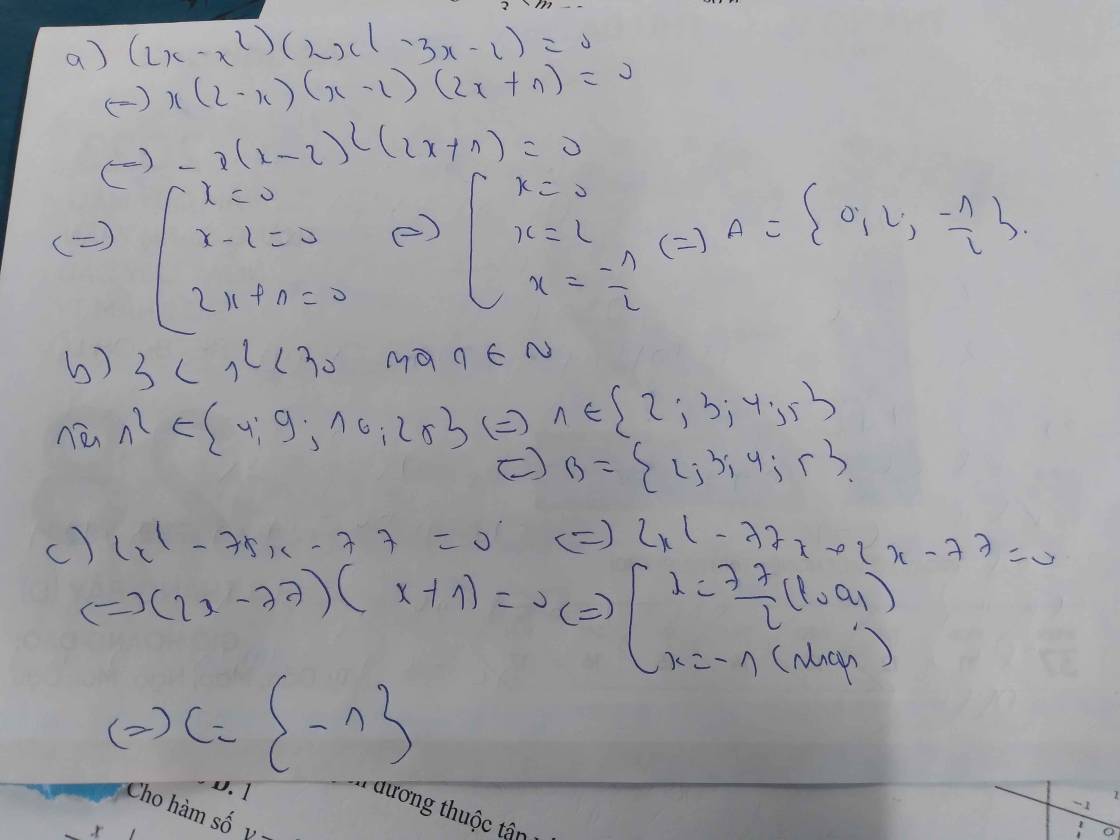Hãy nhập câu hỏi của bạn vào đây, nếu là tài khoản VIP, bạn sẽ được ưu tiên trả lời.

`a)(2x^2-5x+3)(x^2-4x+3)=0`
`<=>[(2x^2-5x+3=0),(x^2-4x+3=0):}<=>[(x=3/2),(x=1),(x=3):}`
`=>A={3/2;1;3}`
`b)(x^2-10x+21)(x^3-x)=0`
`<=>[(x^2-10x+21=0),(x^3-x=0):}<=>[(x=7),(x=3),(x=0),(x=+-1):}`
`=>B={0;+-1;3;7}`
`c)(6x^2-7x+1)(x^2-5x+6)=0`
`<=>[(6x^2-7x+1=0),(x^2-5x+6=0):}<=>[(x=1),(x=1/6),(x=2),(x=3):}`
`=>C={1;1/6;2;3}`
`d)2x^2-5x+3=0<=>[(x=1),(x=3/2):}` Mà `x in Z`
`=>D={1}`
`e){(x+3 < 4+2x),(5x-3 < 4x-1):}<=>{(x > -1),(x < 2):}<=>-1 < x < 2`
Mà `x in N`
`=>E={0;1}`
`f)|x+2| <= 1<=>-1 <= x+2 <= 1<=>-3 <= x <= -1`
Mà `x in Z`
`=>F={-3;-2;-1}`
`g)x < 5` Mà `x in N`
`=>G={0;1;2;3;4}`
`h)x^2+x+3=0` (Vô nghiệm)
`=>H=\emptyset`.

a) \(A = \{ 3;2;1;0; - 1; - 2; - 3; -4; ...\} \)
Tập hợp B là tập các nghiệm nguyên của phương trình \(\left( {5x - 3{x^2}} \right)\left( {{x^2} + 2x - 3} \right) = 0\)
Ta có:
\(\begin{array}{l}\left( {5x - 3{x^2}} \right)\left( {{x^2} + 2x - 3} \right) = 0\\ \Leftrightarrow \left[ \begin{array}{l}5x - 3{x^2} = 0\\{x^2} + 2x - 3 = 0\end{array} \right.\\ \Leftrightarrow \left[ \begin{array}{l}\left[ \begin{array}{l}x = 0\\x = \frac{5}{3}\end{array} \right.\\\left[ \begin{array}{l}x = 1\\x = - 3\end{array} \right.\end{array} \right.\end{array}\)
Vì \(\frac{5}{3} \notin \mathbb Z\) nên \(B = \left\{ { - 3;0;1} \right\}\).
b) \(A \cap B = \left\{ {x \in A|x \in B} \right\} = \{ - 3;0;1\} = B\)
\(A \cup B = \) {\(x \in A\) hoặc \(x \in B\)} \( = \{ 3;2;1;0; - 1; - 2; - 3;...\} = A\)
\(A\,{\rm{\backslash }}\,B = \left\{ {x \in A|x \notin B} \right\} = \{ 3;2;1;0; - 1; - 2; - 3;...\} {\rm{\backslash }}\;\{ - 3;0;1\} = \{ 3;2; - 1; - 2; - 4; - 5; - 6;...\} \)

a) \(2x^3-3x^2-5x=0\)
\(x\left(x+1\right)\left(2x-5\right)=0\)
\(\Rightarrow\left[{}\begin{matrix}x=0\left(L\right)\\x=-1\left(TM\right)\\x=\dfrac{5}{2}\left(L\right)\end{matrix}\right.\)
\(A=\left\{-1\right\}\)
b) \(x< \left|3\right|\)\(\Leftrightarrow-3< x< 3\)
\(B=\left\{-2;-1;1;2\right\}\)
c) \(C=\left\{-3;3;6;9\right\}\)
a) \(A=\left\{x\in Z|2x^3-3x^2-5x=0\right\}\)
\(2x^3-3x^2-5x=0\)
\(\Leftrightarrow x\left(2x^2-3x-5\right)=0\)
\(\Leftrightarrow x\left(x+1\right)\left(2x-5\right)=0\)
\(\Leftrightarrow\left[{}\begin{matrix}x=0\\x=-1\\x=\dfrac{5}{2}\left(loại\right)\end{matrix}\right.\)
\(\Rightarrow A=\left\{0;-1\right\}\)
b) \(B=\left\{-2;-1;0;1;2\right\}\)
c) \(C=\left\{-3;3;6;9\right\}\)

\(A=\left\{x\in R|\left(x-2x^2\right)\left(x^2-3x+2\right)=0\right\}\)
Giải phương trình sau :
\(\left(x-2x^2\right)\left(x^2-3x+2\right)=0\)
\(\Leftrightarrow x\left(1-2x\right)\left(x-1\right)\left(x-2\right)=0\)
\(\Leftrightarrow\left[{}\begin{matrix}x=0\\1-2x=0\\x-1=0\\x-2=0\end{matrix}\right.\) \(\Leftrightarrow\left[{}\begin{matrix}x=0\\x=\dfrac{1}{2}\\x=1\\x=2\end{matrix}\right.\)
\(\Rightarrow A=\left\{0;\dfrac{1}{2};1;2\right\}\)
\(B=\left\{n\in N|3< n\left(n+1\right)< 31\right\}\)
Giải bất phương trình sau :
\(3< n\left(n+1\right)< 31\)
\(\Leftrightarrow\left\{{}\begin{matrix}n\left(n+1\right)>3\\n\left(n+1\right)< 31\end{matrix}\right.\)
\(\Leftrightarrow\left\{{}\begin{matrix}n^2+n-3>0\\n^2+n-31< 0\end{matrix}\right.\)
\(\Leftrightarrow\left\{{}\begin{matrix}n< \dfrac{-1-\sqrt[]{13}}{2}\cup n>\dfrac{-1+\sqrt[]{13}}{2}\\\dfrac{-1-5\sqrt[]{5}}{2}< n< \dfrac{-1+5\sqrt[]{5}}{2}\end{matrix}\right.\)
\(\Leftrightarrow\left[{}\begin{matrix}\dfrac{-1-5\sqrt[]{5}}{2}< n< \dfrac{-1-\sqrt[]{13}}{2}\\\dfrac{-1+\sqrt[]{13}}{2}< n< \dfrac{-1+5\sqrt[]{5}}{2}\end{matrix}\right.\)
Vậy \(B=\left(\dfrac{-1-5\sqrt[]{5}}{2};\dfrac{-1-\sqrt[]{13}}{2}\right)\cup\left(\dfrac{-1+\sqrt[]{13}}{2};\dfrac{-1+5\sqrt[]{5}}{2}\right)\)
\(\Rightarrow A\cap B=\left\{2\right\}\)

a) Liệt kê các phần tử của tập hợp
Ta có: .
Do đó: .
b) Cho hai tập hợp và . Xác định tập .
Ta có:
⚡.
⚡.
Suy ra .

a: A=(-7/4; -1/2]
\(B=\left(-\dfrac{9}{2};-4\right)\cup\left(4;\dfrac{9}{2}\right)\)
\(C=\left(\dfrac{2}{3};+\infty\right)\)
b: \(\left(A\cap B\right)\cap C=\varnothing\)
\(\left(A\cup C\right)\cap\left(B\A\right)\)
\(=(-\dfrac{7}{4};-\dfrac{1}{2}]\cup\left(\dfrac{2}{3};+\infty\right)\cap\left[\left(-\dfrac{9}{2};-4\right)\cup\left(4;\dfrac{9}{2}\right)\right]\)
\(=\left(4;\dfrac{9}{2}\right)\)

A)
\(2x^3-5x+3=0\Leftrightarrow (2x^3-2x)-(3x-3)=0\)
\(\Leftrightarrow 2x(x^2-1)-3(x-1)=0\)
\(\Leftrightarrow 2x(x-1)(x+1)-3(x-1)=0\)
\(\Leftrightarrow (x-1)(2x^2+2x-3)=0\)
\(\Rightarrow \left[\begin{matrix} x=1\\ 2x^2+2x-3=0\end{matrix}\right.\Rightarrow \left[\begin{matrix} x=1\\ x=\frac{-1\pm \sqrt{7}}{2}\end{matrix}\right.\)
Vậy \(A=\left\{1; \frac{-1+\sqrt{7}}{2}; \frac{-1-\sqrt{7}}{2}\right\}\)
B)
Ta có: \(x=\frac{1}{2^a}\geq \frac{1}{8}\)
\(\Rightarrow 2^a\leq 8\Leftrightarrow 2^a\leq 2^3\)
Mà \(a\in\mathbb{N}\Rightarrow a\in\left\{0;1;2;3\right\}\)
\(\Rightarrow x\in\left\{1; \frac{1}{2}; \frac{1}{4}: \frac{1}{8}\right\}\)
Vậy \(B=\left\{1; \frac{1}{2}; \frac{1}{4}; \frac{1}{8}\right\}\)
C) \(C=\left\{x\in\mathbb{N}|x=a^2,a\in\mathbb{N}, x\leq 400\right\}\)
Ta thấy: \(x=a^2\leq 400\)
\(\Leftrightarrow a^2-400\leq 0\Leftrightarrow (a-20)(a+20)\leq 0\)
\(\Leftrightarrow -20\leq a\leq 20\). Mà \(a\in\mathbb{N}\Rightarrow 0\leq a\leq 20\)
\(\Rightarrow a\in\left\{0;1;2;3;...;20\right\}\)
\(\Rightarrow x\in \left\{0^2;1^2;2^2;3^2;....;20^2\right\}\)
Vậy \(C=\left\{0^2;1^2;2^2;,...; 20^2\right\}\)
+)